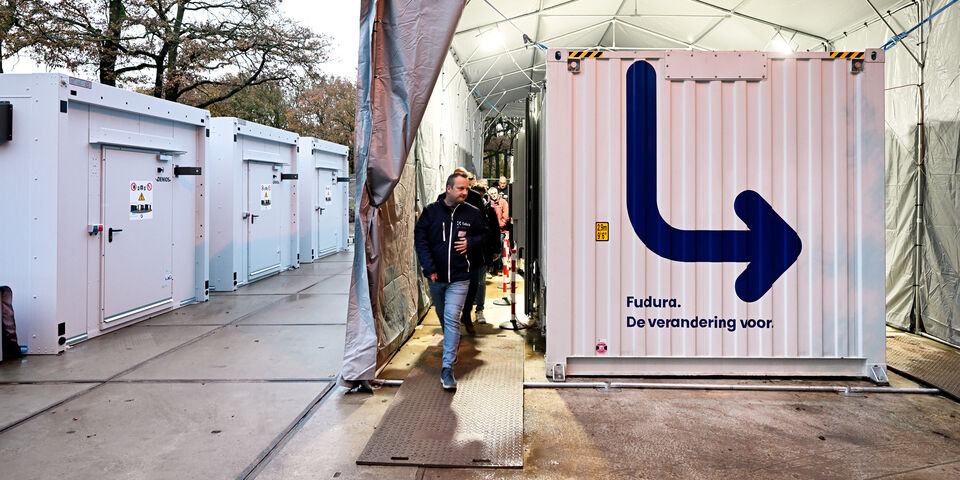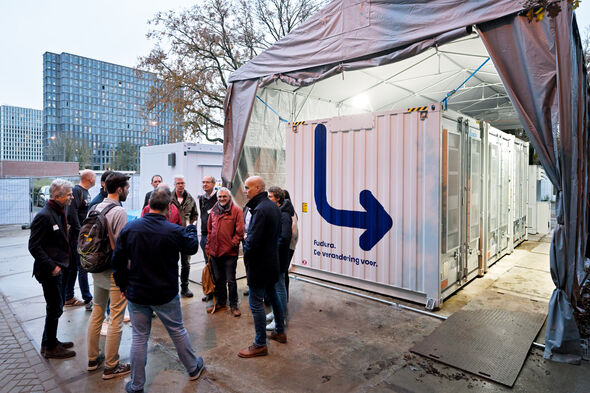The project, in which academic institutions collaborate with a wide range of partners in the region, isn’t only intended to make the campus more sustainable, but also to serve as a blueprint for similar solutions throughout the Netherlands.
Grid congestion is a growing problem in the Netherlands. Due to the limited capacity of the electricity grid, more and more regions are unable to meet the increasing demand for electricity. TU/e also experienced the consequences of this when its grid operator indicated that it could no longer supply additional energy for new projects on campus. The new mega battery solves this problem by storing electricity during quiet hours and releasing it during peak periods. This should help the university use the available power grid more efficiently and save costs.
How does it work?
The lithium iron phosphate battery, which doesn’t contain any cobalt or nickel, is connected to a smart energy platform. This system coordinates the energy use of the more than forty buildings on campus and adjusts it to supply and demand. Thanks to AI, the platform can predict energy needs and advise users on efficient use. This ensures better distribution of peak usage, which benefits not only the university, but also other electricity users in the region.
According to Mark Cox, energy program manager at TU/e, the system will ensure everyone can benefit from a stable and efficient energy supply: ‘The GENIUS battery, in combination with intelligent software, can store energy when demand is low so that we can use it during peak times. Thanks to AI, other users, both on campus and in the local area, will not notice this. On the contrary, everyone can benefit from it,’ he says in a press release on the TU/e website.
More sustainable and cheaper
The battery doesn’t only offer a solution for grid congestion, but also delivers significant savings. The system creates an estimated 20% extra capacity on the university’s internal power grid. As a result, TU/e will need to purchase less electricity during expensive peak hours, which reduces energy costs. In addition, the battery will contribute to reducing carbon emissions and more efficient use of the electricity grid in the region.
Thanks to the smart control by Simpl.Energy’s software, the university will also be able to use the battery to supply energy back to the public network or to share it with nearby users. ‘With our software, we control the battery, charging stations, and solar panels so that TU/e always remains within the connection,’ says Tom Selten, founder of Simpl.Energy, in the press release. ‘In addition, we optimize the purchase of electricity, thereby minimizing energy costs. And as icing on the cake, with our platform, TU/e has one place where they can see whether all systems are working properly and how much is being earned and saved,’ he adds.
Micro-society
The GENIUS project, which is co-financed by the EU through an OPZuid subsidy, serves as a pilot model for tackling grid congestion. Particularly in the south of the Netherlands, where business parks regularly encounter the limitations of the electricity grid, this project can provide valuable insights.
According to TU/e, the project has the capacity to contribute to a more sustainable energy infrastructure at both the local and national scale. The university campus functions as a micro-society in which user behavior is monitored and analyzed. This data can help develop strategies for behavioral change and more efficient energy use.
Promise for the future
President of TU/e Robert-Jan Smits stresses the importance of the project. ‘I am tremendously proud of this project because it brings together a lot of what we stand for as TU/e. With this we are working on sustainability, on solving the grid congestion that all of the entrepreneurial Netherlands is facing, and we are doing this - as a true 4th generation university - in collaboration with a wide range of partners in the region, focused on social impact,’ the press release reads.
The battery promises to be a first step towards large-scale application of these types of systems. If everything goes according to plan, the model can go to market in the future, with the potential for large-scale impact on business parks and other energy-intensive environments. With this project, TU/e doesn’t only hope to contribute to its own sustainability, but also to play a leading role in the broader energy transition of the Netherlands.



Discussion